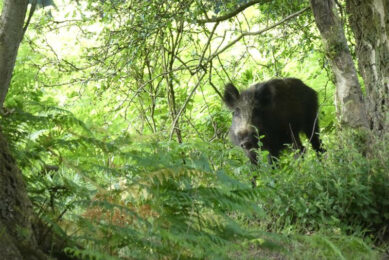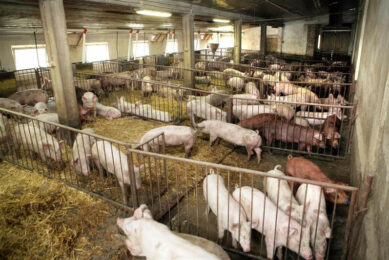Where did China’s ASF infection come from?

Just over 2 months ago, the African Swine Fever virus was confirmed in the world’s largest swine country: China. Ever since, at least 36 outbreaks of the virus have officially been reported in China. Now the question is: how did the virus enter China?
It would be easy to think of Russia to be the route of infection. After all, it is the only bordering country with known ASF outbreaks prior to August 2018. Plus, cut in 2 parts, Russia and China share almost 4,300 km of border, which means that there are plenty of places where the virus could have crossed the border in one way or another.
High similarity of ASF genome
A research conducted by Chinese researchers seems to point in that direction as well. Soon after the 1st outbreaks, they published an analysis of the virus’ genome, found on 3 farms in Shenyang province, China, early August. In a publication in Transboundary Emerging Diseases, they concluded that the gene samples of these 3 farms were the same. They gave it the name ASFv-SY18.
Having compared it to other strains known, the researchers concluded that the Chinese strain belongs to the genotype II group, “and shares 100% nucleotide identity with strains found in Georgia (2007), Krasnodar (2012), Estonia (2014) and Irkutsk (2017).”

Read more on pig health in the Pig Progress Health Tool
The Chinese researchers continued to say: “The results above indicated the close relationship among these viruses, which suggests that the ASF outbreak in China was caused by the pan-Russian strain of ASFv.”
Russia: ASF did not come from Russia
Russia, however, recently dismissed the idea that the virus would have come from Russia. Instead, in posts on its website, the Russian veterinary watchdog Rosselkhoznadzor pointed to others.

Read more about Russia’s swine industry in this analysis
Rosselkhoznadzor stated to have conducted a thorough research of Chinese data following the 1st outbreaks there. The Russian specialists concluded that the Chinese virus isolates were similar to those found in most European countries, including Latvia, Lithuania, Estonia and Poland, as well as from Africa and countries in the Caucasus.
No official pork exports to Russia
Officially, Russia is not directly exporting pork to China at the moment. Rosselkhoznadzor concluded that it must have been likely that ASF has entered China through infected pork products imported from the European Union, as there is a highly developed agricultural trade between the EU and China.
According to several Russian consulting agencies, however, indirect pork exports to China are actually taking place. According to Russian analytical agency Delonovosti, 58% of the country’s pork exports (about 30,000 tonnes) in 2016 ended up in Hong Kong and/or China.
Illegal pork trade
The Chinese researchers, in their article, even pointed at another option: illegal pork trade. In their scientific publication they stated: “In accordance with a liberal trade policy in China, the increasing demand for pork has resulted in a great increase in the volume of live pigs and pork products imported to China. Illegal products imported and waste improperly disposed from international ports and airports to fed pigs are difficult to mitigate.”
ASF outbreaks east of the Ural
In this context, it is interesting to summarise how many African Swine Fever outbreaks have been officially reported in Asian Russia, east of the Ural. They all occurred in 2017, including 2 incidents as far east as Krasnoyarsk and Irkutsk. In total there were 34 reported outbreaks in 6 regions, leading to the death, either by the virus or by culling, of over 20,000 pigs.
Especially the outbreak in Irkutsk is interesting, as when measured in a straight line, it is ‘only’ 1,700 km away from the nearest known outbreak in Inner Mongolia, China. In Irkutsk, the virus was found in a small farm of 40 pigs – and the virus genome identified was identical to the one found in Shenyang. That is known from a scientific publication by Prof Denis Kolbasov and others in the journal Emerging Infectious Diseases from April this year.
ASF might be introduced into China?
The article of Prof Kolbasov closed off with the words: “Since the outbreak in Irkutsk, subsequent ASF outbreaks have occurred in Siberia (March-October 2017) and near the border with China, raising concerns that ASF might be introduced into a population of 500 million pigs.”
In the map below are included the reported ASF outbreaks in Asian Russia (2017, green) as well as those in China (2018, purple).
Other routes for ASF to have travelled?
Apart from the route through the EU, the Russians also hinted to a 3rd possible route: through the Middle East. Theoretically it might have been possible that the virus could have travelled through Iran, Afghanistan and Pakistan. Rosselkhoznadzor stated that, although none of these countries ever reported a single ASF outbreak, the disease could have circulated there without being noticed as the countries do not have a swine business.
Rosselhoznadzor, however, admitted that a scenario in which ASF covered 5,500 km through nature may not be very likely.
Thanks to correspondent Vladislav Vorotnikov who helped compiling this article.












